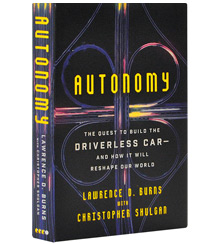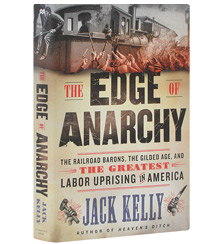Best Business Books 2019: Narratives
Trains, automobiles, and the plain impact of transportation.
William Knoedelseder
Fins: Harley Earl, the Rise of General Motors, and the Glory Days of Detroit (HarperBusiness, 2018)
*A TOP SHELF PICK
Lawrence D. Burns
Autonomy: The Quest to Build the Driverless Car —and How It Will Reshape Our World (with Christopher Shulgan; Ecco, 2018)
Jack Kelly
The Edge of Anarchy: The Railroad Barons, the Gilded Age, and the Greatest Labor Uprising in America (St. Martin’s Press, 2018)
In the U.S., the fortunes of transportation industries and the economy have always been inextricably linked. By the late 1920s, cars were “America’s most valuable product and its number one export,” writes William Knoedelseder in Fins, the best of this year’s crop of business narratives. “The roar of the Twenties was really the sound of America becoming a car economy.” In 1927, when consumers started buying more used cars than new ones, Henry Ford shut down his manufacturing plants for six months, and the economy tipped into a recession. Over the next several years, as the Great Depression set in after the 1929 market crash, job losses caused car sales to plummet further, thus leading to more job losses.
In another of this year’s best business books, Autonomy, author Lawrence D. Burns looks to the future of automobile transport, and concludes it is undergoing a shift more dramatic than anything we’ve seen since 1885, when the internal combustion engine was invented. If Burns is right, the change will transform the entire economy — including, not at all incidentally, the kinds of jobs that are available. The often fraught and fragile relationship between transportation industries and the humans who do the work is the topic of the third of this year’s best narrative business books, Jack Kelly’s The Edge of Anarchy.
Knoedelseder’s volume tops the list thanks to his rich portrayal of the auto industry’s boom years, and the men (they were mostly men) who made it all happen. The author of several books, including one on the Anheuser-Busch dynasty, Knoedelseder tells the story mainly through Harley Earl, who from the 1920s until the 1950s created the look of General Motors’ cars, and by extension, the look of American cars. Harley operated as a “kind of combination Steve Jobs and Tom Ford of his time,” Knoedelseder writes.
Harley Earl oversaw the creation of what would become the defining image of 1950s postwar America: the tail fin.
The son of a lumberjack, Earl, born in 1893, got his start designing custom car bodies for movie stars in nascent Hollywood, when today’s glittering streets were still groves of citrus. In the 1920s, he moved to Detroit at the behest of GM CEO Alfred Sloan, who turned a dysfunctional rollup of hundreds of independent carmakers into America’s most formidable corporation. Over a 30-year period, which coincided with GM’s dominance, Earl had an enormous behind-the-scenes impact on the auto industry. “By the mid-1950s, every design department in the industry had adopted his system, his techniques, and even his theories,” writes Knoedelseder. “Every studio was filled with — if not directed by — men he had trained.”
It was Earl who oversaw the creation of what would become the defining image of 1950s postwar America: the tail fin. At first, Knoedelseder recounts, buyers reacted so badly to the feature, which was first introduced on the 1948 Cadillac, that it inspired internal arguments at GM. But as the cars began to appear on the street, something strange happened. People wanted them. By the end of the year, GM sales had hit a record level. “The end result was an automobile that perfectly captured America’s sense of itself at the dawn of the 1950s — powerful, exceptional, and in Harley’s word, ‘significant,’” Knoedelseder writes.
By the 1950s, GM was the most successful company in the history of business, selling more than three times as many cars as its next rival. That’s when the company decided to build the General Motors Technical Center, which Knoedelseder writes was “unlike any corporate facility ever before imagined.” At a cost of US$125 million — the equivalent of more than $1 billion today — the modernist structure, designed by Eero Saarinen, was supposed to be the physical representation of GM’s legacy, which Sloan said would be “greater than we have ever known.”
Driverless driving
Looking back, the splashy building is a reminder of a business rule I first heard after Enron’s bankruptcy: Sell when they build a monument to self. It turned out that the 1950s were in many ways a high-water mark for the U.S. auto industry. By the mid-1990s, Burns, who then served as the corporate vice president of research, development, and planning at GM, was calling the company “a healthcare company that just happened to make cars.” Years of concessions to the United Auto Workers (UAW) union had resulted in a huge surplus of workers, all of whom were guaranteed employment. A dozen years later, both GM and Detroit would declare bankruptcy in the dark aftermath of the global financial crisis.
Juxtaposed with Fins, Autonomy is a poignant reminder of how the mighty can fall. Could a denizen of the 1950s, an era in which one in six workers toiled in the auto industry, have imagined that a book about the future of transportation wouldn’t be set in Detroit? More shocking yet, if you believe Burns, Detroit’s core product — the automobile with a single occupant, the driver — may be headed for extinction. In its place, Burns believes, we’ll travel via what he calls “mobility services based on electric powered and driverless vehicles, paid for by trip or through subscriptions.” Or as Google folks call it, transportation-as-a-service.
Burns has spent his life as both an insider and an outsider in the auto industry. He grew up in Michigan and went to a cooperative college that was a feeder school for GM, where he began work in 1978 and stayed for the ensuing three decades. But he also got his Ph.D. at Berkeley in transportation systems and, then, from inside the beast, began to preach a very un-Detroit-like message of sustainability. In his telling, Harley Earl’s innovations, from fins to chrome, are part of the senseless Veblen-esque conspicuous consumption that pervades the current auto industry. “The system is completely irrational,” he writes. After all, our vehicles sit idle most of the time, in garages (what a waste of space), and when they’re in use, they are mostly transporting a single occupant; just 1 percent of the fossil fuel that powers these huge vehicles goes to move the driver, says Burns — who also points out that more than 90 percent of accidents are caused by humans.
There are plenty of human characters in Burns’s book, but the major drama is between Detroit and Silicon Valley. Just as the auto industry was hitting its nadir, DARPA, an agency of the Department of Defense, began sponsoring races between self-driving robots. At the 2007 race, GM backed a car designed by a Carnegie Mellon team — but, Burns notes, he was the only senior executive from Detroit who showed up. “GM still thought of the technology as distant science fiction,” he writes. In contrast, Silicon Valley came in force: Larry Page, Sergey Brin, and a planeload of other senior Google executives flew in to cheer on the Stanford team.
The divides were deep, and they are instructive in a world where Silicon Valley’s innovations are upending many existing industries. At cash-rich Google, Larry Page argued that because an autonomous car business could be worth more than Google itself, it was worth founding — even if its chance of succeeding was only 10 percent. Detroit, on the other hand, couldn’t figure out how to keep its existing businesses out of bankruptcy, let alone fund pie-in-the-sky new ones. Nor could Detroit’s executives contemplate taking the driver out of the equation. As Harley Earl had seemed to prove, the purpose of a car was to cater to the driver.
Of course, as Burns notes, once Google began to try manufacturing even simple cars, the company realized that (a) the process was entirely different and much more difficult than designing software, and (b) Detroit did have something to contribute. Burns argues that now, with multiple deals done between the new world and the old world — including between Google’s Waymo and Fiat Chrysler — there is cooperation and respect, and an acknowledgment that although the “scale of the challenge is much bigger than any of us envisioned,” the transition to a world that bears little resemblance to Jack Kerouac’s On the Road is “inevitable.”
Burns is a futurist and an analyst, so he believes that he can quantify the change. According to his analysis, “technology currently available could converge to provide transportation at less than a fifth of its current cost.” The other effects of transportation-as-a-service are equally huge: a dramatic drop in emissions; much lower demand for oil; and much more freedom for the very old, the very young, and the differently abled. Burns also argues that the switch will save people an immense amount of time — 72 billion hours a year, to be precise. Which, he says, “many of us could use to work additional hours at our jobs.” (Hmmm.)
With these assets come liabilities: the jobs that will be lost. On that list Burns includes 8 billion hours of paid driving work and a huge reduction in the number of employees required to assemble vehicles — both of which, he notes, could well contribute to income inequality. In his view, government efforts such as retraining and tax credits can help alleviate some of the resulting dislocation. Those may indeed help. But if we are collectively unable to come up with better alternatives, we are likely to see the sorts of social dislocations and labor unrest we saw in the late 19th century.
Striking out
The tangle between labor and capital in the transportation industry in a period of economic tumult is the subject of The Edge of Anarchy, by historian and journalist Jack Kelly. In the 1890s, railroads were the primary means of moving goods and people around the United States. But in 1893 and 1894, both the railroad industry and the U.S. economy were in crisis. Overinvestment in railroads had resulted in dozens of bankruptcies — and, of course, job losses and drastic cuts in wages. The Panic of 1893 ignited a deep and long recession, “an economic slough of despond unparalleled in its history,” Kelly writes. But “the panic that had swept Wall Street was nothing compared to the mental anguish of those who shouldered the real economic burden.”
In the spring of 1894, labor leader Eugene Debs went to war with industrialist George Pullman in what the New York Times called the “greatest strike in history.” Pullman’s railcar workers, who had slowly been relegated to making a meager living by piecework, and who paid much of what they did make as rent for their homes in the Pullman-owned model town in Chicago where they lived, couldn’t feed their families on the reduced wages. They couldn’t understand why Pullman’s shareholders were still being paid rich dividends. Their strike, which began in May 1894, was quickly followed by that of many railroad workers, which effectively shut down the system the U.S. had come to rely on not just for transportation, but for food.
In obvious ways, Pullman and Debs, whose conflict animates Edge of Anarchy, were very different. Debs, an idealist, lifelong supporter of labor, and five-time Socialist candidate for president, created the American Railway Union as a way of unifying unskilled workers. He believed, writes Kelly, that a “sense of common interest…could balance the dominant ethos of individualism” and famously said that “one of our fundamental doctrines is that labor and capital are brothers.” Pullman, on the other hand, helped set the tone for the era that Mark Twain labeled the Gilded Age, both with the extravagance of the Pullman sleeping cars and with his own monied life; his Chicago home featured a 200-seat theater. Pullman saw no brotherhood. Kelly writes that he “would run his business as he saw fit, even if his men were forced to work for starvation wages.”
But in less obvious ways, there were similarities. Both men were sure of the righteousness of their causes — perhaps too sure. As Kelly writes, “each felt that he was a patriot upholding the best of the American tradition.” And so it was that the battle was joined.
It was a battle that Debs ultimately lost, mainly because President Grover Cleveland’s administration served not as a neutral arbitrator, but rather as an enabler of railroad imperialism. Cleveland had signed a law awarding $26 million in loans to private railroad companies and had promised that “no harm shall come to any business interest as the result of administrative policy so long as I am president.” He hired as attorney general Richard Olney, a former corporate counsel for — you guessed it — the railroads, who made it his “personal mission to bring [Debs’s] union to its knees.” Through the manipulation of existing laws, mainly one that forbade interference with the delivery of mail, he did, even managing to get Debs a jail sentence.
The Pullman Strike, which ended in July 1894, was followed by three decades of retrenchment for labor, but Kelly argues that it did “contribute to the dawning of the progressive era.” By the early 1950s, the peak of General Motors’ power, the proportion of unionized employees had reached nearly 35 percent of the nonagricultural labor force. Then came the steady loss of manufacturing jobs and, starting in the 1980s, a political shift. That, of course, was followed by dark days for the auto industry, caused in no small part by the concessions they’d made to the UAW in flusher times. Today, only 6.4 percent (pdf) of private-sector workers are union members. Tomorrow, it is possible to imagine that much of the transport sector won’t need workers at all.
But that doesn’t mean the tension between economic efficiency and human dignity is going away. The questions raised by Jack Kelly in writing about an episode from the late 19th century are, in fact, painfully relevant in the early 21st century. “We have repeatedly put to the test the question of whether our creed rests on a foundation of individualism and private property or of solidarity grounded in equality and mutual sympathy,” Kelly writes. “During the great railroad conflict of 1894, these two ideals collided violently. A resolution could not be found then. It eludes us to this day.”
Author profile:
- Bethany McLean is the coauthor of The Smartest Guys in the Room. Her most recent book is Saudi America: The Truth about Fracking and How It’s Changing America. A contributing editor at Vanity Fair, she hosts the podcast Making a Killing.








